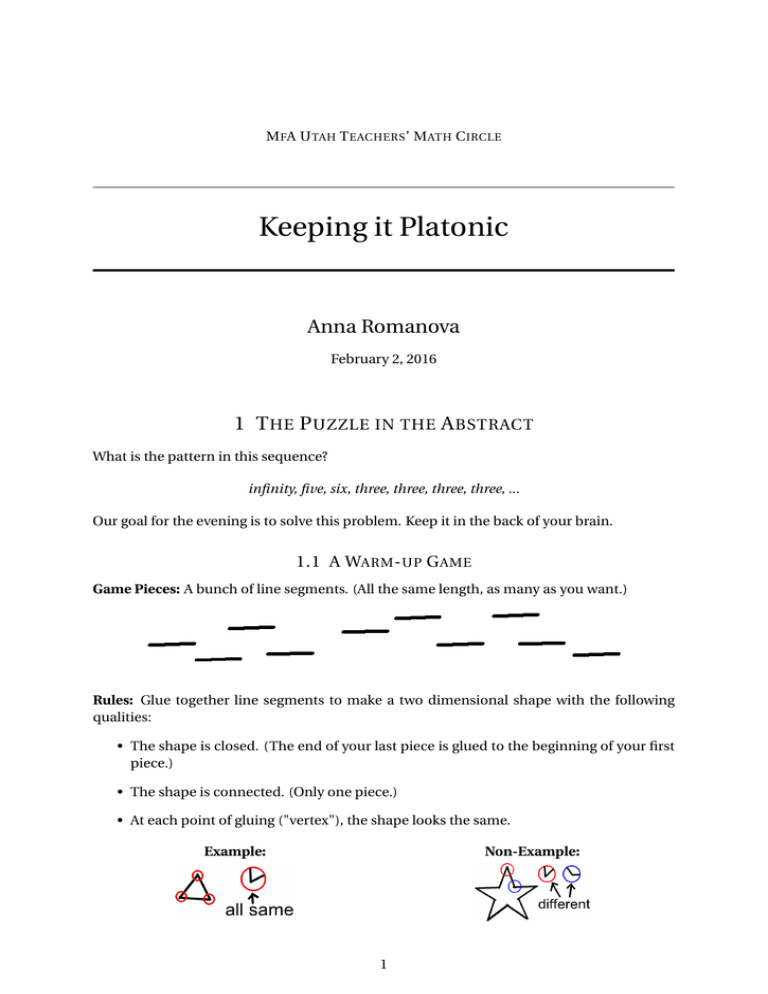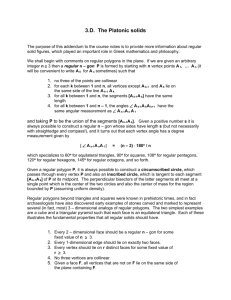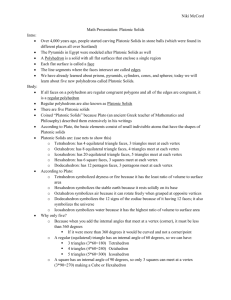Keeping it Platonic Anna Romanova 1 T P
advertisement

M FA U TAH T EACHERS ’ M ATH C IRCLE Keeping it Platonic Anna Romanova February 2, 2016 1 T HE P UZZLE IN THE A BSTRACT What is the pattern in this sequence? infinity, five, six, three, three, three, three, ... Our goal for the evening is to solve this problem. Keep it in the back of your brain. 1.1 A WARM - UP G AME Game Pieces: A bunch of line segments. (All the same length, as many as you want.) Rules: Glue together line segments to make a two dimensional shape with the following qualities: • The shape is closed. (The end of your last piece is glued to the beginning of your first piece.) • The shape is connected. (Only one piece.) • At each point of gluing ("vertex"), the shape looks the same. Example: Non-Example: 1 What can you come up with? 1.2 S AME G AME , H IGHER D IMENSION Game Pieces: The solutions of the last game. Rules: Glue together regular n-gons to make a three dimensional shape with the following qualities: • The shape is closed. (You could put it inside of a ball.) • The shape is connected. (Only one piece.) • At each vertex, the shape looks the same. Non-Example: Example: What can you come up with? (Hint: There are five.) 2 But how do we know that there are only five? 2 A P ROOF The answers to the last game are called the Platonic solids. We build them from regular ngons. We can prove constructively that there are only five. The key fact that we use is that Platonic solids must look the same at every vertex. Our plan will be to build potential solutions by analyzing how they look at a single vertex, then showing that this vertex structure matches one of the five solids we constructed. 2.1 T RIANGLES Start with the smallest regular n-gon, an equilateral triangle, and try to build Platonic solids. Question 1: Can we construct a Platonic solid with two equilateral triangles meeting at a vertex? What goes wrong? What does the number of edges meeting at a vertex tell us about the dimension of the object? Question 2: What if three triangles meet at a vertex? Question 3: What if four triangles meet at a vertex? Question 4: What if five triangles meet at a vertex? Question 5: What if six triangles meet at a vertex? How many Platonic solids can be built from equilateral triangles? 3 2.2 S QUARES The next smallest regular n-gon is a square. Question 1: What if three squares meet at a vertex? Question 2: What if four squares meet at a vertex? How many Platonic solids can be built from squares? 2.3 P ENTAGONS Next we look at regular pentagons. You can probably guess how we’ll proceed. Question 1: What if three pentagons meet at a vertex? Question 2: What if four pentagons meet at a vertex? How many Platonic solids can be built from pentagons? 2.4 HEXAGONS Question 1: What if three hexagons meet at a vertex? 4 How many Platonic solids can be built from hexagons? Can we build Platonic solids from n-gons for n greater than 6? 3 P LATONIC S OLIDS ARE N EAT Platonic solids have fascinated mathematicians for centuries. They also have an interesting way of showing up in nature. • Plato (427-347 B.C.) described in his dialogue Timaeus a theory that the universe was built from regular convex polyhedra. The cube is earth, the tetrahedron is fire, the icosahedron is water, the octahedron is air, and the dodecahedron is "quintessence." • Roughly 2000 years later in 1596, Kepler noticed that the platonic solids could be nested inside each other in a way that seemed to correspond with the orbits of the six known planets of the time. • Viruses and other organisms like zoo plankton often form in the shape of Platonic solids. 5 • Crystals also take the shape of Platonic solids. The mathematics of group theory and representation theory can be used to study crystal growth in some surprising ways. 4 A T RICKIER G AME Game Pieces: The solutions of the last game, Platonic solids. Rules: Glue together Platonic solids to make a four dimensional shape with the following qualities: • The shape is closed. • The shape is connected. • At each point vertex, the shape looks the same. This is much harder. We can’t see four dimensions. But we can try to implement some strategies from our three dimensional proof to tackle the problem. Solutions to this game are called regular convex 4-polytopes. 4.1 TETRAHEDRA When we were constructing Platonic solids, we started with equilateral triangles. Similarly, we can start this problem with tetrahedra. Let’s try to build the simplest solution to this game using the simplest platonic solid. Our strategy will be a higher dimensional analogue to the strategy used earlier: Start with some collection of 3d "faces" (tetrahedra) meeting at a vertex, then "fold them up" in the fourth dimension to complete the polytope. This is much easier to think about if you have some tetrahedra to play with. 6 Question 1: Can we build a solution from two tetrahedra meeting at a vertex? Why or why not? What do the number of edges meeting at a vertex tell us about the dimension of the object we form? Question 2: What if three tetrahedra meet at a vertex? In our 3D case, "folding up" the solid meant gluing the two unconnected edges to each other. What is the analogue of "folding up" the object in this case? In other words, what parts of the tetrahedra do we need to glue together? In our previous proof, we only needed to analyze the behavior at one vertex because we just had to check that it matched one of the solutions we already came up with. But now, we need to construct solutions from scratch. This means that it isn’t enough to analyze the behavior at one vertex. We need to think about how the rest of the polytope will fit together. Question 3: Can we glue two tetrahedra along two of their triangular faces? If we do this, what happens to the third face? Question 4: What is the minimum number of tetrahedra that we need to be sure that the problem described in Question 3 doesn’t happen? Question 5: Can you think of a way to glue together this minimal number of tetrahedra so that three tetrahedra meet at each vertex? If so, this is our first solution! The polytope you just constructed is called a "hypertetrahedron" or "5-cell." 7 4.2 CUBES The five tetrahedra in the previous question, along with the blueprint of how to glue them together are called a net. We have nets in the lower dimensional cases as well. For example, here is a net of a cube: Question 1: What are the associations you need to make on the net above to glue it into a cube? Question 2: Using the cube net as guidance, can you come up with a net for a "hypercube" (which is another solution to our game) that is made up of eight cubes? 4.3 T HE OTHER S OLUTIONS Constructing the rest of the solutions to this problem is difficult, but entirely possible using similar arguments to the ones we have used so far. However, you might need more than a Tuesday night to figure them out. Here are a few more things to think about. Question 1: How many other solutions can you make from tetrahedra? From cubes? Octahedra? Dodecahedra? Question 2: Why can’t you make any 4-polytopes from icosahedra? Question 3: How many solutions are there to this game? 8 5 T HE A NSWERS IN THE B ACK OF THE B OOK There are six convex regular 4-polytopes. Since they are four dimensional objects, we cannot see them. However, we can see three dimensional projections of them. Here are three dimensional stereographic projections of our solutions. 5-cell: five tetrahedral faces 8-cell/hypercube: eight cubic faces 16-cell: 16 tetrahedral faces 24-cell: 24 octehedral faces 120-cell: 120 dodecahedral faces 600-cell: 600 tetrahedral faces 9 6 F UN In case you haven’t gotten enough of regular polytopes, here is some bedtime reading. 6.1 H ISTORY As you experienced, the construction of these 4-polytopes is not easy. Which makes it all the more impressive that the person who first constructed them in this way (using only methods of Euclidean geometry) was an eighteen year old Irish woman with no formal mathematics education. This is Alicia Boole Stott: Alicia was born in 1860 to George Boole, a mathematician, and Mary Everest Boole, a librarian and educator. Alicia’s father died when she was only four years old, and her mother was forced to move her five daughters to London so that she could take a job as a librarian at Queens College, the first women’s college in England. Alicia and her sisters were educated by their mother, but since the family was very poor, they had no chance for formal education. However, through her mother’s library, Alicia was exposed to the academic circles of 19th century London whose members included names like Charles Darwin and H.G. Wells. One of the academics who Alicia spent time with was her brother-in-law, mathematician Charles Howard Hinton. At the time, Charles was working on a paper titled "What is the Fourth Dimension," and invited Alicia to help him analyze the problem with a set of little wooden cubes. Alicia proved to be a natural at understanding four dimensional geometry, and quickly surpassed Charles with her ability to visualize the fourth dimension. When she was just 18 years old, she coined the word "polytope," and discovered using only Euclidean methods the existence of the six regular convex 4-polytopes. Alicia continued her work in four dimensional geometry, and published several papers on it throughout her lifetime. She never did complete her formal education, but collaborated with mathematicians across Europe, including Pieter Schoute and H.S.M. Coxeter, and was awarded an honorary degree by the University of Groningen in 1914. 10 6.2 GAMES Are you feeling like our three dimensional world is holding you back? Do you yearn to see the world from the inside of a hypercube? You aren’t alone! Henry Segerman and Vi Hart also wanted to experience this freedom, so they made it happen. Whip out your smart phone or tablet and head to www.hypernom.com Once you arrive, choose your 4-polytope of choice (my favorite is the hyperdodecahedron in the lower right hand corner), and start looking around. As you look at each dodecahedral face, it "pops." Can you pop all 120 of them? Still not satisfied? Try www.monkeys.hypernom.com Now you can experience Vi Hart and Henry Segerman’s sculpture More Fun than a Hypercube of Monkeys (2014). This hypercube of monkeys is an example of an object with quaternion symmetry. It’s also pretty cute. 6.3 T HE P UZZLE IN THE A BSTRACT Question: What is the pattern in this sequence? infinity, five, six, three, three, three, three, ... Answer: The number of regular polytopes in dimensions 2, 3, 4, 5, 6, etc. If we were to continue our game to higher dimensions, we would find fewer solutions than we did in four dimensions! This is a beautiful example of the rich and mysterious world of four dimensional geometry. 7 B IBLIOGRAPHY • The pictures of 4-polytopes come from the Wikipedia page on Regular 4-Polytopes. They were released into the public domain by their author Fritz Obermeyer. • The information about Alicia Boole Stott comes from this bibliography: http://wwwhistory.mcs.st-andrews.ac.uk/Biographies/Stott.html • And this bibliography: http://www.ams.org/samplings/feature-column/fcarc-boole • The hypernom site was created by Henry Segerman, Vi Hart, Andrea Hawksley and Marc ten Bosch. • This workshop was loosely based on some entries in Joh Baez’s blog This Week’s Finds in Mathematical Physics (This one in particular: http://math.ucr.edu/home/baez/platonic.html) If you were interested in the subject matter of this workshop, the hundreds of readable, entertaining entries in Professor Baez’s blog are well worth your time. 11







